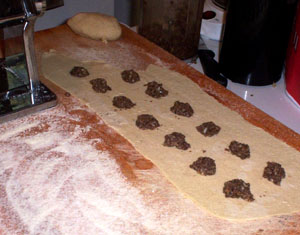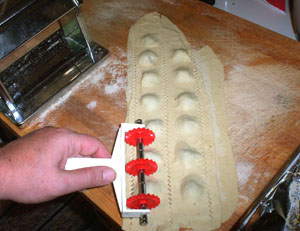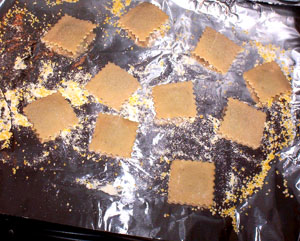|
Although
it's not by any means a "quick and easy" meal, I
get a great deal of pleasure from occassionally
making my own pasta at home and using it in
creative ways. There's also nothing quite like
simple, satisfying taste of fresh pasta made from
nothing but semolina and water, cooked to a perfect
texture, eaten the same day it's made.
Making your
own pasta is best with a pasta machine and a helper
to turn the crank. (Otherwise it's a three-handed
job, which can be done with dexterity and a lot of
practice, but is not an easy thing.) If you
don't have a pasta machine, however, this recipe
can be made by rolling out the dough with a rolling
pin until it is as thin as you can make it and
still handle it easily.
This is
something you want to start a couple hours or more
before you plan to eat. A Saturday afternoon kind
of project.

The
Filling
1/2 cup or
so of mushrooms, preferable ones with intense
flavor (porcini, morels, etc.)
1 bulb garlic, roasted
a pinch of red chili powder
Use a food
processor or similar tool to blend the ingredients
into a thick paste.
The
Pasta
1 cup (or a
bit more) durum semolina
warm water, as needed
Put the
semolina in a bowl, and add the water gradually,
incorporating it into the flour with your hands.
When you can form the dough into a dense ball that
doesn't crack but is not wet enough to be sticky,
the dough is ready.
Sprinkle the
work surface with semolina flour and set up the
pasta machine. Divide the dough into a couple
smaller balls. With the pasta machine set at the
lowest (thickest) setting, run one ball of pasta
through several times. Increase the setting one
notch at a time, running the pasta through once or
twice at each setting. When it becomes awkwardly
long, divide it with a nice and continue, running
both pieces through at each consecutive setting. I
usually stop at 6 or sometimes 5 if it seems to be
stretching unevenly.
|
Filling
the Ravioli
Place
small daubs of filling on one sheet of the
pasta. My pasta machine came with a
ravioli cutting contraption that makes the
scalloped edges and cuts ravioli of
uniform size. I use this to very lightly
mark the sheet in the pattern it will be
cut in, as a guide to placing the filling.
If you don't have a ravioli cutter, just
place the daubs of filling in a uniform
pattern, with whatever spacing you like.
Make sure the pasta sheet is large enough
to extend beyond the edges of the ravioli,
at least a quarter inch (more is
better).
Using
fingers dipped in water, wet the pasta
slightly in between the daubs of filling.
This will help seal the individual ravioli
when you cut them out.
Gently
lay the second pasta sheet on top of the
first. With fingers, gently work to move
air bubbles toward the edge of the sheets,
where they can be expelled. If this
doesn't work perfectly, it will not cause
a huge problem.
If
a hole develops in the pasta, you can
sometimes mend it with a small scrap of
pasta from the edge of the sheet,
well-moistened and patted over the hole to
seal it.
Now
cut the ravioli using a ravioli cutter (a
pizza cutter is a viable alternative, a
sharp knife works if you have nothing
else).
To
dry the ravioli, I use aluminum foil
scattered with some coarse corn meal. It's
crucial that they are not on a surface
where they can stick (to the surface or to
each other). I keep an eye on them and
move them around or turn them over to help
them dry nicely without
sticking.
You
can take the leftover dough from the
edges, form it into a ball, and process it
again to make more ravioli. If you keep
this up, there will be very little
leftover pasta. (You might want to save it
as a "tester" to judge the cooking time
for the ravioli.) You should get 20
or more ravioli.
Leave
the ravioli to dry until they are quite
firm and are no longer tacky, a half hour
or more.
|



|
The Herb
Sauce
1 cup or so
fresh garden herbs (I used equal parts
oregano, basil, and parsley)
a small tomato, or a handful of cherry or grape
tomatoes
1/4 cup olive oil
It's best to
make this while the water is heating to boil the
ravioli. Warm the olive oil over medium heat. Chop
the herbs and tomatoes coarsely and add to the
olive oil. When the herbs wilt, reduce the heat to
the lowest setting.
Cooking
the Ravioli
Use your
largest cooking pot, and lots of water. Salt the
water with a tablespoon or two of salt. Bring the
water to a rolling boil and add the ravioli, all at
once or as quickly as you can manage. They should
cook in a few minutes. Test by cutting a little
piece off the enge of one, or by using a tester
piece of pasta in the water. With practice, you can
tell by how they look. I generally cook mine for
five minutes or so.
Drain the
ravioli and toss with the warm herb sauce. Serves
two.
Ingredient
Corner
Semolina is
a hard, slightly coarse flour made from durum
wheat. Do not use regular flour.
Porcini or
morel mushrooms are usually sold dehydrated. Bring
them back to life by pouring boiling water over
them and letting them sit for half an hour. You can
add some of the soaking water to the filling for
extra flavor
|